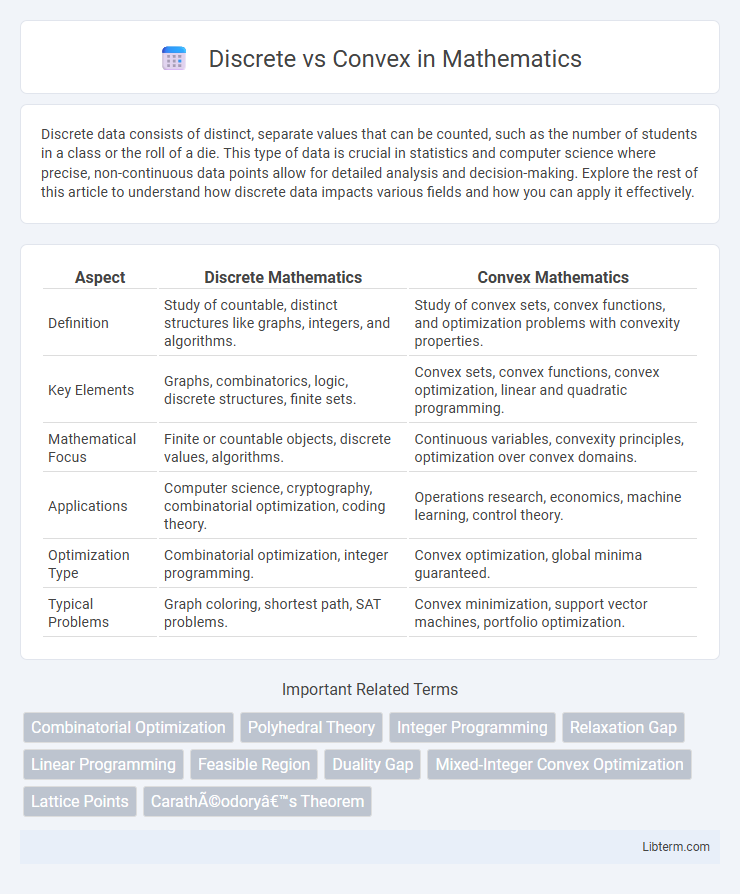Discrete data consists of distinct, separate values that can be counted, such as the number of students in a class or the roll of a die. This type of data is crucial in statistics and computer science where precise, non-continuous data points allow for detailed analysis and decision-making. Explore the rest of this article to understand how discrete data impacts various fields and how you can apply it effectively.
Table of Comparison
| Aspect | Discrete Mathematics | Convex Mathematics |
|---|---|---|
| Definition | Study of countable, distinct structures like graphs, integers, and algorithms. | Study of convex sets, convex functions, and optimization problems with convexity properties. |
| Key Elements | Graphs, combinatorics, logic, discrete structures, finite sets. | Convex sets, convex functions, convex optimization, linear and quadratic programming. |
| Mathematical Focus | Finite or countable objects, discrete values, algorithms. | Continuous variables, convexity principles, optimization over convex domains. |
| Applications | Computer science, cryptography, combinatorial optimization, coding theory. | Operations research, economics, machine learning, control theory. |
| Optimization Type | Combinatorial optimization, integer programming. | Convex optimization, global minima guaranteed. |
| Typical Problems | Graph coloring, shortest path, SAT problems. | Convex minimization, support vector machines, portfolio optimization. |
Introduction to Discrete and Convex Concepts
Discrete concepts involve distinct, separate values often represented by integers or finite sets, crucial in fields like computer science and combinatorics. Convex concepts pertain to continuous sets or functions where any line segment between two points lies entirely within the set, forming the basis of convex optimization and economics. Understanding the fundamental differences between discrete and convex structures enables efficient problem-solving in optimization, algorithm design, and mathematical modeling.
Defining Discrete Structures
Discrete structures consist of distinct or separate elements often used in computer science, mathematics, and combinatorics to model countable, finite, or infinite sets such as graphs, trees, and finite automata. Convex structures, in contrast, relate to continuous geometric shapes where any line segment connecting two points within the shape lies entirely inside it, characterizing convex sets and convex functions essential in optimization theory. Defining discrete structures emphasizes their inherent non-continuous nature and fundamental role in algorithm design, data organization, and logical reasoning.
Understanding Convex Sets
Convex sets are fundamental in optimization and defined as subsets of vector spaces where, for any two points within the set, the entire line segment connecting them also lies inside the set. Understanding convex sets enables efficient problem-solving by leveraging properties such as closure under convex combinations and the existence of supporting hyperplanes. In contrast, discrete sets consist of isolated points without such continuum properties, making convexity concepts less applicable.
Key Differences Between Discrete and Convex
Discrete optimization involves decision variables that take on distinct, separate values often integers, while convex optimization deals with continuous variables within a convex feasible region. The key difference lies in solution space structure: discrete problems have non-convex, often combinatorial solution sets, making them generally NP-hard, whereas convex problems have convex solution spaces that guarantee global optima found efficiently. Algorithms like branch-and-bound or dynamic programming address discrete problems, while gradient-based methods or interior-point algorithms are effective for convex problems.
Examples of Discrete and Convex Applications
Discrete optimization problems commonly arise in scheduling tasks, such as job assignments and vehicle routing, where decisions involve selecting distinct options from a finite set. Convex optimization frequently appears in machine learning for training models like support vector machines and logistic regression, leveraging convex loss functions to ensure global optimality. Integer programming in supply chain management exemplifies discrete applications, while portfolio optimization in finance demonstrates convex optimization's role in risk management and asset allocation.
The Role of Discreteness in Optimization
Discreteness in optimization involves variables that take on distinct, separate values, often represented as integers or binary states, contrasting with the continuous nature of convex optimization where variables can assume any value within a convex set. The role of discreteness is crucial in combinatorial optimization problems, such as scheduling, routing, and resource allocation, where the solution space is inherently finite yet exponentially large. Discrete optimization methods rely on specialized algorithms like branch-and-bound, cutting planes, and integer programming to handle the complexity arising from non-convex, non-smooth feasible regions.
Convexity in Mathematical Programming
Convexity in mathematical programming ensures that the feasible region and objective function exhibit properties like convex sets and convex functions, enabling efficient optimization. Convex problems guarantee global optima without local minima traps due to the convex nature of the solution space. This contrasts with discrete programming, where solution spaces are often non-convex and combinatorial, complicating optimization strategies.
Discrete vs Convex in Computational Complexity
Discrete optimization problems involve variables taking on distinct, separated values, often integers or finite sets, making them generally NP-hard and challenging to solve efficiently. Convex optimization problems have continuous variables over convex sets with convex objective functions, enabling polynomial-time solvability through well-established algorithms like interior-point methods. The stark contrast in computational complexity hinges on the problem structure, where convex problems benefit from global optimality guarantees and efficient solvers, unlike discrete problems which frequently require combinatorial approaches or approximation algorithms.
Real-world Problems: Discrete vs Convex Approaches
Discrete approaches model problems using distinct, separate values often applied in scheduling, network design, and resource allocation, where variables represent countable entities or decisions. Convex methods leverage smooth, continuous optimization techniques ideal for problems with convex objective functions and constraints, such as portfolio optimization, machine learning, and control systems, ensuring globally optimal solutions. Real-world problem-solving requires choosing discrete formulations for combinatorial challenges and convex models for scalable, efficient optimization in continuous domains.
Conclusion: Choosing Between Discrete and Convex
Choosing between discrete and convex optimization depends on the problem's structure and the desired solution properties. Discrete optimization excels in scenarios requiring integer or combinatorial solutions, such as scheduling or network design, while convex optimization is preferred for continuous, smoothly varying problems due to its guaranteed global optimality and efficient solvability. Understanding the problem domain and computational resources is crucial for selecting the appropriate optimization approach.
Discrete Infographic

 libterm.com
libterm.com